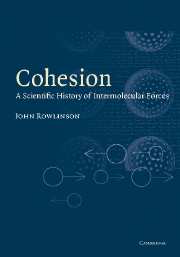1 - Introduction and summary
Published online by Cambridge University Press: 27 July 2009
Summary
Some problems have always been with us. No one knows when man first asked ‘What is the origin of our world?’ or ‘What is life?’, and progress towards satisfactory answers has been slow and exceedingly difficult. One aim of this study is to take such a perennial theme, although one narrower than either of these two problems, and see how it has been tackled in the Western world in the last three hundred years. The topic is that of cohesion – why does matter stick together? Why do gases condense to liquids, liquids freeze to solids or, as it has been put more vividly, why, when we lift one end of a stick, does the other end come up too? Such questions make sense at all times and the attempts to answer them have an intrinsic interest, for the subject of cohesion has at many times in the last three centuries been an important component of the physical science of the day. It has attracted the attention of some of the leading scientists of each era, as well as a wide range of the less well known. It is a part of our history that is worth setting out in some detail, a task that I think has not yet been attempted.
- Type
- Chapter
- Information
- CohesionA Scientific History of Intermolecular Forces, pp. 1 - 7Publisher: Cambridge University PressPrint publication year: 2002



